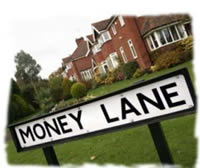

A Buy to Let mortgage often requires a deposit of 15% against the purchase price - Although through www.mortgage-desk.com clients of Its-Property can obtain 90% mortgages - thus only a 10% deposit being required.
Whilst many schemes exist - the business end of a Buy to Let mortgage is the rate you pay. Using independent brokers we can help you secure market leading rates and keep your costs down.
Download the Latest Buy to Let Mortgage information (click to open, or right-click and select "Save Target As" to Save):

(Don't worry -- your e-mail address
is totally secure. We promise to use it only to
send you relevant Property Investment Information from Its Property).
Typically it can often pay to purchase your property with finance in the form of a buy to let mortgage. The reasons are mainly down to:
1) Gearing (explained below)
2) Tax efficient
3) Build large portfolios
1 - Gearing - a 7% return or 46.6% - the choice is yours!
Gearing is the term used when a property is purchased using finance in the shape of a Buy to Let mortgage - the property is termed to have been "geared" or "leveraged". For example if you have £50,000 capital and you purchase a £50,000 property outright and the value of this house in one year increased 7% - the value a year later would be £50,000 * 7% = £53,500. The return or gain you would have made on your capital (£50,000) would be £3,500 - or expressed as a percentage 7% - common sense really.
However if you had decided you obtain a buy to let mortgage on your new purchase the sums would look like this;
Purchase Price £50,000
Mortgage available - 85% of purchase price = £42,500
Deposit (your investment) = £7,500
Mortgage payments - at typical rate of 5% = £177**Whilst admittedly you do have a monthly liability of £177 to the mortgage company - this should be taken care of by the rent - Indeed mortgage companies like to see that the property can rented for 25-30% more than the mortgage payment to meet any voids.
But the return on your capital is where the excitement starts - previously the return was 7%.
The property was purchased for £50,000 and is now worth £53,500 same as above - except you only used a £7,500 deposit. So your return is now £3,500 / £7,500 or 46.6%.
You have nearly doubled your original deposit - slightly better would you say?
2- Tax Efficient
A Buy to Let property is treated by the inland revenue as a "business", that means you have to pay taxes on the income received. That said, it does mean you can offset any typical costs against income received - mortgage payment interest can be offset. Therefore by having an interest only mortgage you can reduce your tax liabilities.
E.g. A property with no mortgage on it (unencumbered) - means all the income is taxed at the individuals highest rate - apart from wear and tear there is little to offset.
A property that is mortgaged, typically means that the outgoings initially start higher and in the early years, little or no tax is payable. Through clever planning and by using tax efficient saving schemes like ISA's it is possible to create a tax free lump sum to discharge the mortgage some way down the line, like retirement?
3- Create large portfolios
Through a combination of 1 & 2 - it can be demonstrated that larger amounts of properties can be purchased. Based on a property price of £50,000 and deposit required of £7,500 - it is possible to purchase 6 properties with mortgages as against to only one with no mortgage.
Thus a portfolio over a small amount of time of £300,000 can be secured. If property prices increased 7% per annum for 5 years (typical rate of growth for property since records began (HM Land Registry) - then in 2010 the portfolio could be worth - £590,000- with mortgages totaling £255,000- Equity of £335,000.This represents a total return on capital of 670%. This does not even take into account any rent received during those 5 years!